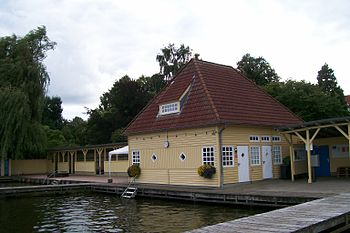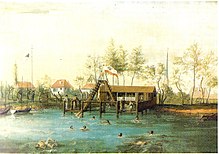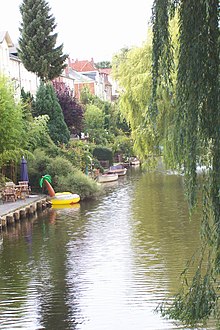Outdoor pool at the Falkenwiese
The outdoor pool at the Falkenwiese (also the Falkenwiese natural pool ) is a listed river swimming pool in the Hanseatic city of Lübeck (Schleswig-Holstein).
The pool is located east of the old town on the island since the Middle Ages dammed Wakenitz in the amount of Falkenwiese on Wakenitzufer in the district St. Jürgen . It is also used for cultural events.
history
Kreidemannsche institute
As early as 1799, Lübeck an der Wakenitz had owned a bathing establishment established and maintained by the Society for the Promotion of Charitable Activities , which the swimming instructor Anton Kreidemann had set up as a Kreidemannsche institute south of today's open-air swimming pool at the level of the later Dorotheenstraße. It was one of the oldest swimming pools in northern Germany and had a swimming pool from which swimmers could reach the Wakenitz. The bathing establishment, initially with eight changing rooms, has been expanded several times. The private swimming pool was demolished in 1898 when it had to give way to the culvert in connection with the construction of the Elbe-Lübeck Canal . He drained the Wakenitz after the construction of the Falkendamm in the direction of the mill pond. From the culvert downriver, the lake-like dammed Wakenitz had a low flow velocity in its northern area.
Falkenwiese outdoor pool
The city of Lübeck built a new outdoor swimming pool to replace the Kreidemannsche Anstalt on the Falkenwiese. The Falkenwiese was used for falconry and falconry in the Middle Ages. The swimming pool was opened as the Falkenwiese bathing establishment on June 20, 1899 , and the Lübeck school garden was built in the immediate vicinity the following year . Initially, only men were allowed to visit the outdoor pool. Since 1907 women were also allowed to visit the institution for a few hours a day. Until the 1980s, the wooden bathing establishment had separate entrances for men and women, which gave men and women direct access to the changing rooms. The visit was free, only the use of hot water showers had to be paid for. The outdoor swimming pool was particularly popular with residents in the area between Moltkestrasse, Falkenwiese, Falkenstrasse and Wakenitzufer, where multi-storey residential buildings as well as double and single residential buildings were built at the beginning of the 20th century. Vacant lots on former horticultural areas were closed after the end of the Second World War.
When the city of Lübeck got into financial difficulties in the 80s, the closure of the outdoor pool was discussed again and again; especially after the building was damaged by arson in the summer of 1989. Citizens' protest caused the city to abandon its plans, the building was restored and placed under monument protection in 1997.
In September 1999, citizens of Lübeck founded a development association to support Lübeck Swimming Pools, to ensure operation over the long term and to reduce operating and maintenance costs. In July 2001, the city recognized the open-air swimming pool as a local environmental and development policy project in accordance with UNESCO's Agenda 21 . The Association for the Promotion of the Outdoor Swimming Pool received recognition as an Agenda 21 project of the State of Schleswig-Holstein from the State Office for Nature and Environment in October 2001. The recognition was combined with a grant of 5,000 marks. In the same year, the city agreed to partially finance a new pontoon to replace a wooden platform in the Wakenitz. The friends' association also planned to add a lawn to the outdoor pool to make it more attractive for families with children. The city made the necessary area available by resolution of the citizenship in January 2002. For this, the hiking trail on the Wakenitz was relocated; the neighboring playground has been made smaller. Until the sunbathing lawn was set up, only the wooden bathing jetties and paved areas in front of the shower and changing rooms were available to users. The outdoor pool was also provided with a tent roof, which enables events.
In 2005, the Falkenwiese Natural Baths Association took fourth place in the Schleswig-Holstein Citizens' Prize.
In 2006, the public-private partnership project Drei Naturbäder , which includes the outdoor pool on the Falkenwiese, the Wakenitz outdoor pool in Marli on the east side and the outdoor pool in Eichholz an der Wakenitz, received an innovation award from the magazine authorities Spiegel and the federal association PPP .
Plant and use
The outdoor pool, which is suitable for competitions with 50-meter lanes, has a water depth of between 40 centimeters and 1.20 meters in the 1220 square meter non-swimmer area and 2.80 meters to three meters deep in the 2750 square meter swimming area. It has a one-meter diving board, a three-meter diving board and a water slide. For events it is equipped with a 250 square meter tent roof and a floating stage with a mobile roof. It is used for swimming lessons and a wide variety of events such as theater and music performances, summer parties, and readings. In 2003 the German-Ibero-American Society Lübeck organized the Fiesta Latina in the outdoor pool with the Portuguese band Calypso and other artists. The private Lübeck Theater Partout made guest appearances in the outdoor pool with performances such as Der gläserne Bogen in 2003 or the Oscar Wilde adaptation Der Fischer und seine Seele in 2005. In June 2006 the writer and dramaturge John von Düffel read at an event at the Lübeck Buddenbrookhaus in the outdoor pool from his debut novel Vom Wasser and the short story book swimming .
The outdoor pool has been the destination of the WakenitzMan swimming competition since 1998. The best-known participant in 2011 was the extreme swimmer Bruno Dobelmann , who a few days earlier had been the first swimmer to cross the Belt twice .
literature
- Meike Müller: St. Jürgen - Chronicle of a suburb and its village environment , small booklets on city history, Archive of the Hanseatic City of Lübeck (Ed.), Book 14, Lübeck 1998, page 34, page 53 and 54 ISBN 3-7950-3113-3
Web links
- Falkenwiese outdoor pool
- Photo of the outdoor swimming pool with a tent roof
- Official website of the Falkenwiese natural pool
Individual evidence
- ↑ Outdoor swimming pool under monument protection since 1997 ( Memento of the original from September 29, 2007 in the Internet Archive ) Info: The archive link was automatically inserted and not yet checked. Please check the original and archive link according to the instructions and then remove this notice.
- ↑ Lübeck project ( Memento of the original from September 29, 2007 in the Internet Archive ) Info: The archive link was inserted automatically and has not yet been checked. Please check the original and archive link according to the instructions and then remove this notice. of Agenda 21
- ↑ Recognition of the Agenda 21 project by the state of Schleswig-Holstein ( memento of the original from September 29, 2007 in the Internet Archive ) Info: The archive link has been inserted automatically and has not yet been checked. Please check the original and archive link according to the instructions and then remove this notice.
- ↑ Citizenship resolution on the provision of a green area for a lawn of January 24, 2002, agenda item 11.11 (PDF; 1.3 MB)
- ↑ Fourth place of the Schleswig-Holstein Citizens' Prize 2005
- ↑ Innovation Prize PPP 2006
- ↑ TriSport Lübeck eV ( Memento of the original from November 27, 2013 in the Internet Archive ) Info: The archive link was automatically inserted and not yet checked. Please check the original and archive link according to the instructions and then remove this notice.
- ↑ Popular Swabian . In: Lübecker Nachrichten of August 2, 2011, p. 21
Coordinates: 53 ° 52 ′ 10 ″ N , 10 ° 42 ′ 16 ″ E



